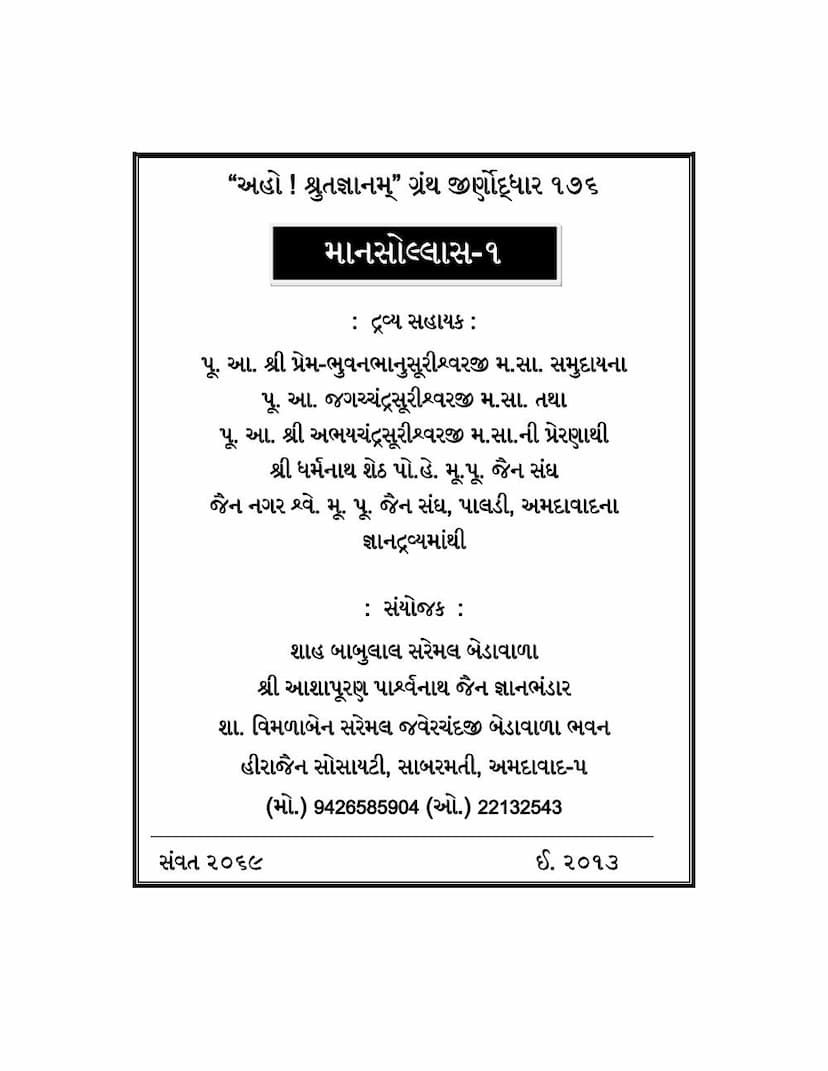Mansollas Satik Part 01
Added to library: September 2, 2025

Summary
This document is the first part of the Mānasollāsa, also known as Abhilṣitārthacintāmaṇi, a Sanskrit encyclopedic work attributed to King Someśvara of the Western Chalukya dynasty.
Key aspects and content of the provided text:
-
Publication Details:
- The text is published by the Oriental Institute, Baroda, as part of the Gaekwad's Oriental Series and the Government of India Sanskrit Book Re-print Series.
- The first edition was in 1925, and a reprint was released in 1967.
- The work is attributed to King Someśvara, son of Vikramaditya VI, who reigned in the 12th century.
- The General Editor for the reprint was B. J. Sandesara.
- The work is described as a "veritable encyclopaedia in Sanskrit" and is important for studying the cultural conditions of medieval India.
-
Authorship and Date:
- While the colophon attributes the work to King Someśvara himself, the preface suggests it might have been composed by a learned courtier familiar with royal affairs, as a king making such a self-aggrandizing comparison is unlikely.
- The date of composition is estimated to be around 1131 AD (1052 Saka) based on a dhruvāṅka (a specific calculation related to astronomical positions).
- There's a discussion about the controversy surrounding Someśvara's accession date (1124-27 AD), but it doesn't materially conflict with the composition date.
-
Structure and Content of Volume I:
- The Mānasollāsa is a voluminous work divided into five Vimsatis (sections), each containing 20 Adhyāyas (chapters), totaling 100 chapters.
- Volume I contains the first two Vimsatis, comprising 40 chapters.
- The preface outlines the vast scope of the work, covering "one hundred different topics on the necessities and written for the instruction of the members of royal families."
-
Nature of the Work:
- It's written in Anustubh meter with occasional prose passages.
- The language is described as "easy but florid."
- The work aims to provide maximum information in minimum space and is called mārgadēni (a book that teaches the world).
- It provides a picture of the "glories, pomps and paraphernalia of a purely Indian court and royal household."
-
Specific Topics Covered (from the preface and table of contents):
- First Vimsati: Generally focuses on the qualifications and necessities for an ambitious king aiming to expand his dominion.
- Chapters cover virtues, rules of conduct (avoiding falsehood, harming others, etc.), duties towards family, teachers, guests, and the public.
- It details the importance of tirthasnan (bathing in sacred rivers) and lists several, though notable omissions like Pushkar are mentioned.
- It discusses the administration of medicines, particularly those derived from plants, with no mention of metallic preparations.
- Emphasis is placed on the king's responsibility for the welfare of the distressed.
- Second Vimsati: Primarily focuses on ways to secure the king's position.
- Covers kingly qualifications, rasāyana (rejuvenation), the roles and qualifications of various state officials (ministers, priests, treasurers, guards, physicians, cooks, etc.).
- Discusses kingdom administration, taxation (including land produce, honey, ghee), and the importance of an organized army.
- Details elephant management, including catching, training, and warfare. Specific methods like Vāribandha (similar to Kheddah) are mentioned.
- Covers gemology (testing pearls, rubies, emeralds, etc.), treasury management, and the importance of fortifications.
- Includes discussions on various types of warfare, army formations (vyūhas), and strategic considerations.
- It elaborates on subjects like astrology, divination (śakuna), and the importance of auspicious timing and omens for various activities.
- There are chapters on medicinal treatises, arts, and possibly other sciences.
- First Vimsati: Generally focuses on the qualifications and necessities for an ambitious king aiming to expand his dominion.
-
Notable Observations from the Preface:
- The author emphasizes the life of the king being in danger, as evidenced by the qualifications of the royal cook (unbuyable and able to test food).
- The text reflects an awareness of the potential for corruption among clerical professions.
- The king's wealth is calculated based on the number of elephants.
- The work includes detailed descriptions of various aspects of royal life, from personal hygiene and attire to entertainment and diplomacy.
- It highlights the importance of Ayurvedic medicines derived from plants.
- The author mentions various historical and geographical references, indicating a broad knowledge base.
The provided pages list numerous Jain texts that have been scanned and digitized into DVDs as part of a project called "Aho! Śrutajñānam Granth Jīrṇōddhār." This indicates that the Mānasollāsa itself is part of a larger effort to preserve and disseminate rare Jain and other Indian manuscripts. The title Mānasollās Satik Part 01 suggests this is a scholarly edition with commentary or that it's the first part of a commentary on the Mānasollāsa. The inclusion of many Jain texts in the catalog links points to the involvement of Jain institutions in this preservation effort.